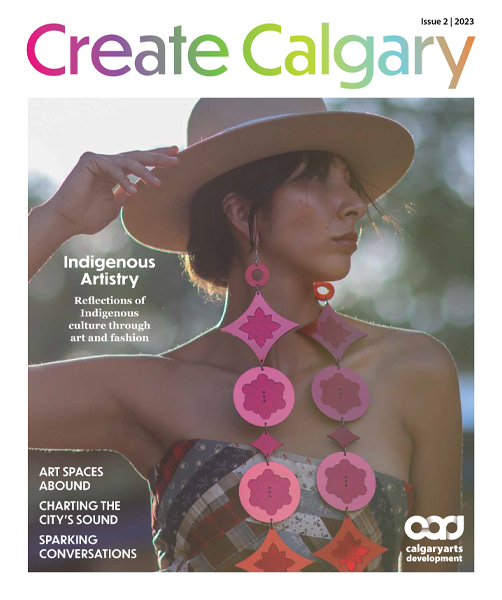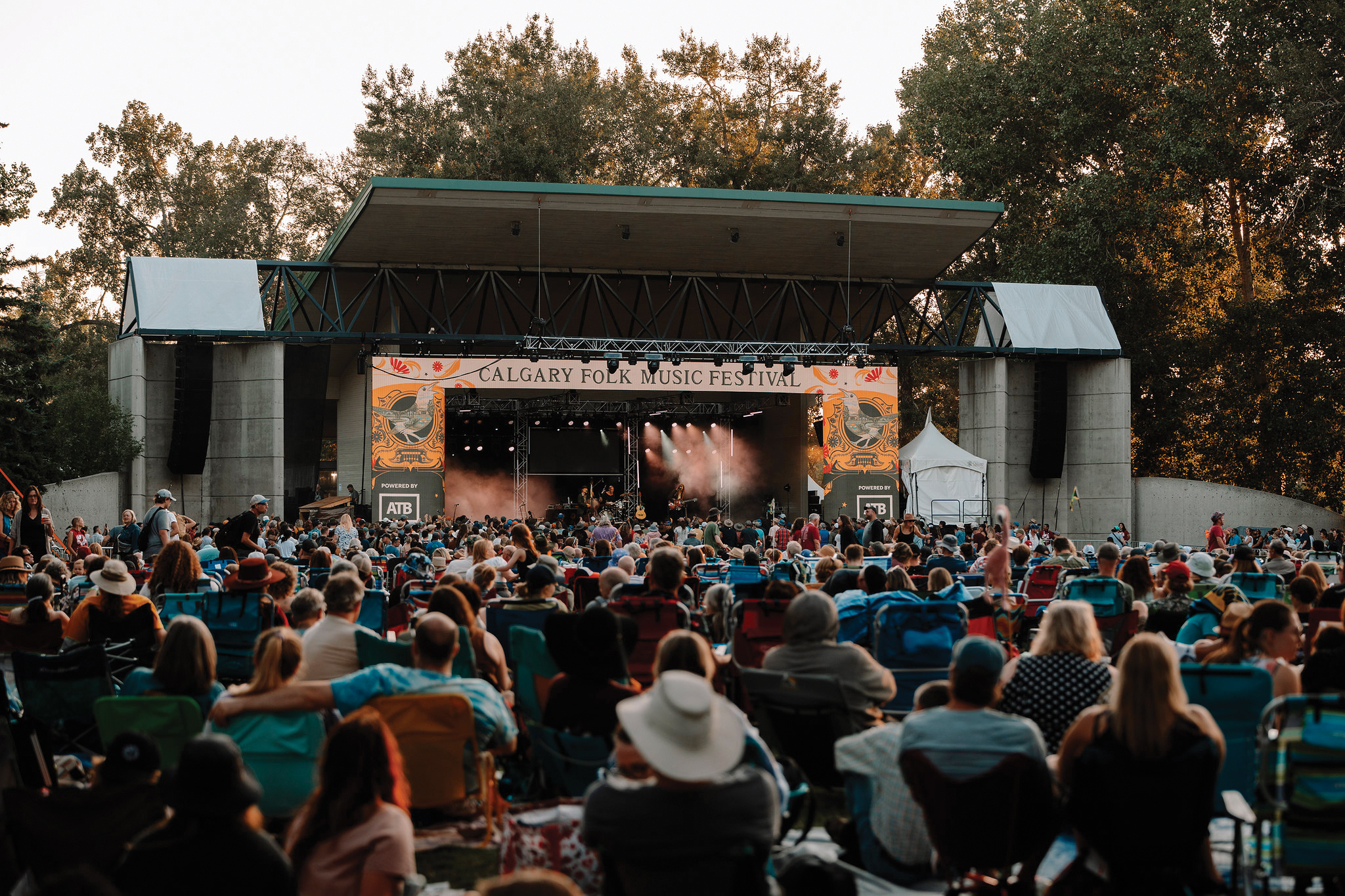Soundtrack of the City
En route to becoming a true music city, Calgary’s unique and collaborative music scene makes way for a burgeoning array of rising artists and audiences
Certain experiences feel undeniably Calgarian: anything having to do with Stampede, ice skating at Olympic Plaza or Bowness Park, rafting past downtown along the Bow on a perfectly sunny afternoon. The annual Calgary Folk Music Festival is right up there — swaying on Prince’s Island Park as you listen to international legends play alongside established local heroes like Reuben and the Dark or Astral Swans on a warm July night.
This is one of the most joyous experiences a Calgarian can have, bringing together our city’s unique geography, social community and longstanding appreciation for music. Folk Fest may not be everyone’s cup of tea, but similarly moving musical experiences can be found via a performance by the Calgary Philharmonic Orchestra, a night of venue-hopping during June’s Sled Island music and arts festival, a raucous honky-tonk tent during Stampede week or a blues-soaked jam in a club anywhere along the Music Mile. Calgary might not have the big music industry infrastructure of cities like Toronto or Nashville, but music has long represented the beating heart of the city.
AN EVER-EVOLVING MUSICAL LANDSCAPE
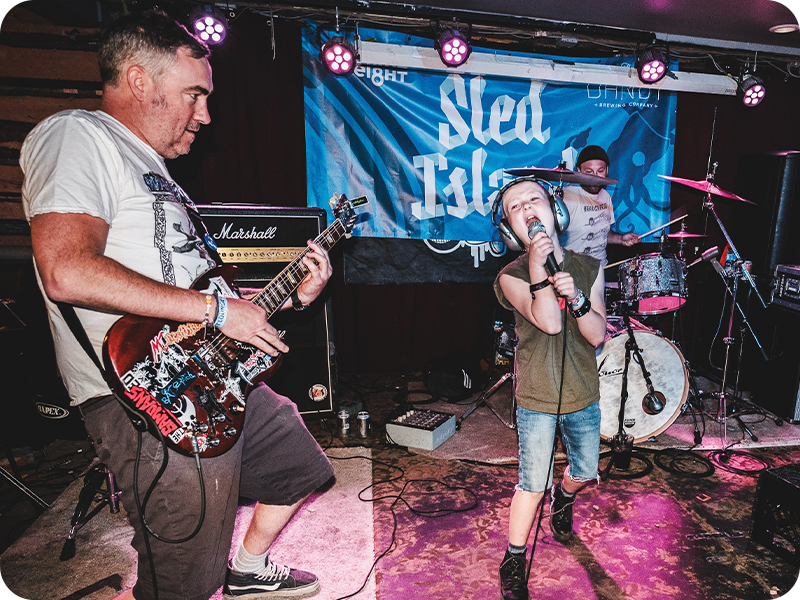
Bat Scratch performing at the Palomino during Sled Island 2023. Photo by Shane Rempel, provided courtesy of Sled Island.
If we’re talking about the modern popular music era, Calgary’s music scene has developed much like that of any other mid-sized North American city. As the city grew throughout the 20th century, local orchestral and jazz ensembles gave way to folk singers, pop crooners and rock bands, with touring groups coming through to play a ramshackle collection of local bars and larger venues like the University of Calgary’s MacEwan Hall Ballroom, the Jack Singer Concert Hall, the Max Bell Centre, and, eventually, the Saddledome. By the ’90s, Calgary was producing its fair share of rock, punk, country and hip-hop artists, though not necessarily differentiating itself as a destination music city in the same vein as American landmarks like Seattle, Washington and Austin, Texas.
Mike Bell, a longtime local music journalist and [former] editor-in-chief of The YYScene, says Calgary’s various music scenes, ranging across genres and scales of venues, have really come of age over the last decade or so. The emergence of externally popular artists like Feist, Tegan and Sara, and k.d. lang — all of whom, to be fair, left Calgary to find their respective fame, but are still closely associated with both Calgary and Alberta — has certainly helped Calgarians dreaming of a music career to realize that the sky is the limit, in terms of success.
Perhaps more importantly, the potentially global audiences and music production tools afforded by the internet and other technologies have allowed artists to envision a viable music career without having to leave the city to make a name for themselves. Bell believes that as Calgary has grown as a city and local musicians have collectively developed a certain sense of confidence, it’s helped to bolster creativity and collaboration that encourages artists to push boundaries without having to leave home.
“We’re kind of a little island here in the prairies,” Bell says. “Previously, musicians were being true to themselves, but they also had an eye on either Vancouver or Toronto, so the sound needed to be something commercially palatable. A change came in the early ’00s. It became more about musicians making music for themselves and making it for Calgary.”
TAKING CENTRE STAGE
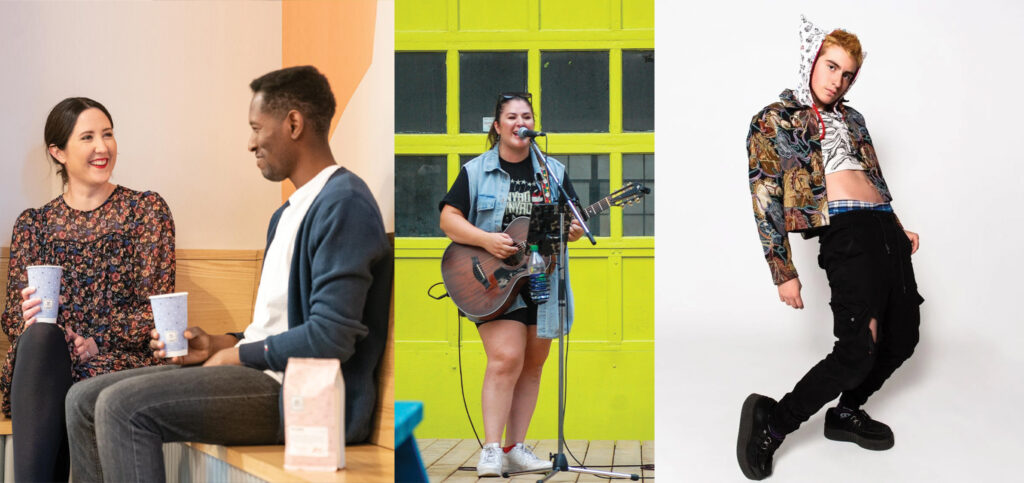
Left to right: Ellen Doty with 2022 collaborator Biboye Onanuga; Michela Sheedy performing a Curbside Concert; ElyOtto. Photos courtesy Spencer Gatt; Curbside Concerts; Jenn Five.
This maturation of Calgary’s music landscape is multi-faceted. Festivals like the aforementioned Folk Fest (and its sister winter festival Block Heater), Sled Island, Stampede, JazzYYC, the Honens piano competition and Big Winter Classic expose both audiences and budding musicians to acts from around the world while widening audiences for local artists booked on those same bills. The National Music Centre acts in a similar capacity year-round, placing local musicians on the same stages and in the same exhibits as nationally renowned artists, giving context to Calgarians’ contributions to the larger scope of Canadian music.
This collaborative phenomenon isn’t just happening on the stages of the Jack Singer, The Palace Theatre and the bandstands of Prince’s Island Park. Smaller artists are feeding off each other in clubs like the King Eddy, The Ironwood Stage and Grill, Palomino Smokehouse, Ship and Anchor, and Commonwealth Bar & Stage. On a grassroots level, the city has recently seen local musician Matt Masters’ pandemic-born Curbside Concerts bringing live music to neighbourhoods throughout the city and local teenage synth pop phenomenon ElyOtto score a record deal based on a viral TikTok hit recorded in his bedroom.
Local jazz singer Ellen Doty’s annual holiday fundraiser with Monogram Coffee sees her recording a duet with a musician from a different genre every year to raise money for a local charity — all demonstrating the growing level of cooperation within the city. “There’s a new ‘if it’s good for you, it’s good for all of us’ attitude,” Bell says. “I’ve been seeing collaborations between rock and jazz artists, and hip-hop and rock artists, as well as so much collaboration within just the hip-hop community. We’re in a really healthy place right now.”
STRONGER MUSIC MAKES FOR A STRONGER CITY
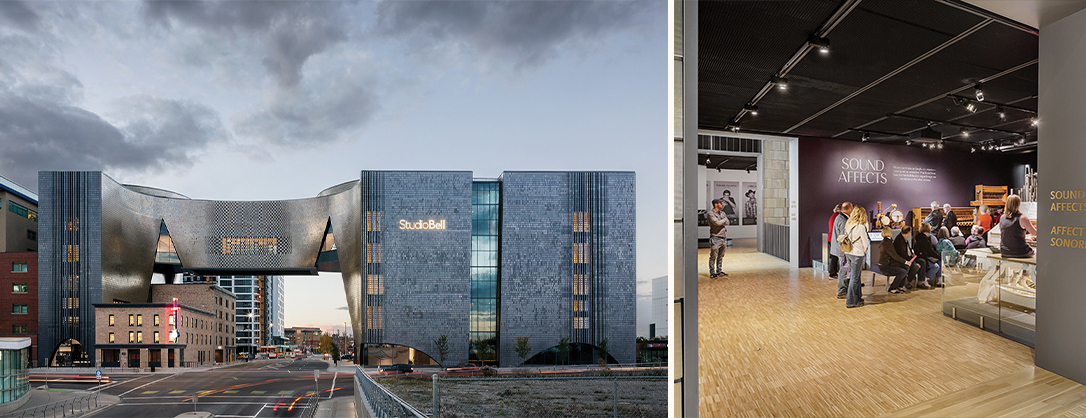
Studio Bell, home of the National Music Centre. Photos courtesy of Studio Bell.
All of this collaboration and cultivation is wonderful for career musicians and stalwart music fans who intentionally seek out live shows, but a healthy music scene does not live in a vacuum. When live music thrives, the benefits trickle down to more casual music appreciators who enjoy stumbling upon unfamiliar artists performing in a restaurant or café and even, albeit indirectly, people who don’t care about live music at all.
Kaley Beisiegel, a musician and the principal consultant at Bird Creatives, helps prepare research and reports for West Anthem, a body “established to help stimulate the growth and sustainability of Alberta’s music industry.” In 2020, West Anthem released a report based on pre-pandemic data from 2017, revealing that the music industry was responsible for a GDP of $820.26 million in Calgary alone (province-wide, the music-related GDP was $2.1 billion). The music business also encompassed 8,400 jobs in the city, employing artists, teachers, sound technicians, PR representatives, producers and other industry professionals.
“Those are quite significant numbers,” Beisiegel says. “For folks who aren’t into music, when you can actually put the concrete data and dollar value behind it, they can see how music is contributing to our overall quality of life and the overall economy of the city.”
West Anthem is working on adjusting its findings to reflect how Calgary’s music economy has shifted since the beginning of the pandemic. An update released this past June shows that while music professionals saw a wage drop in the first year of the pandemic, there was only a 3.27 per cent decline in jobs, signifying that the local music industry weathered the storm of pandemic-related restrictions as well as could be expected, with strength to bounce back now that everything from concert halls to blues bars are back in full swing.
CREATING A CITY OF SOUND
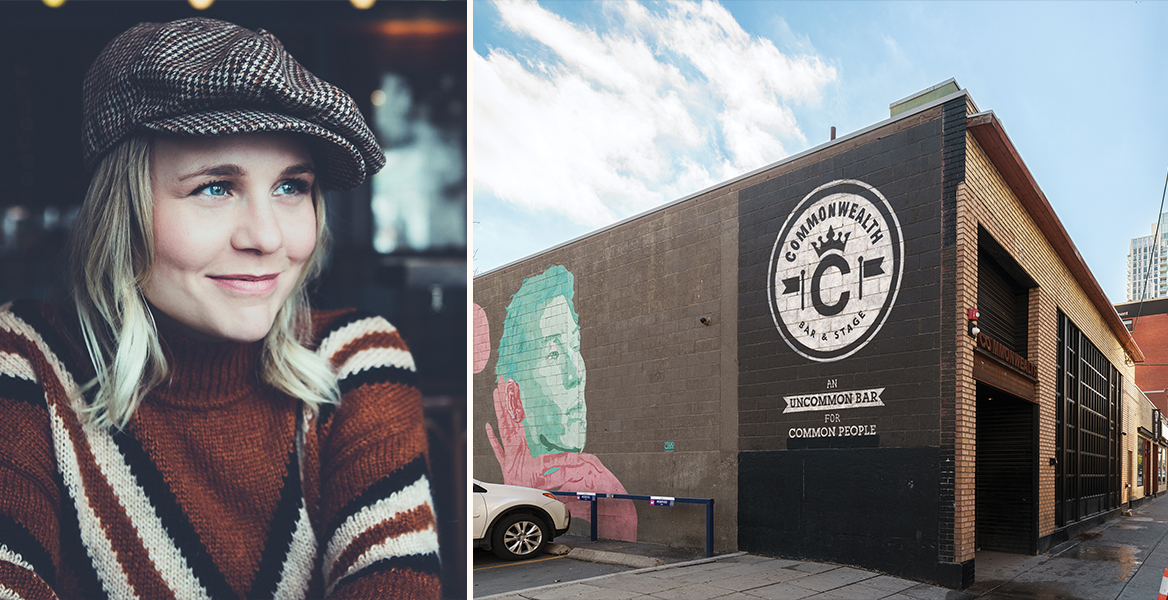
Kaley Beisiegel (l) and Commonweath Bar & Stage. Photos courtesy of Bird Creatives and Commonwealth.
One of West Anthem’s goals is to establish Calgary as a “Music City,” defined as “communities of various sizes that have a vibrant music economy, which they actively promote.” Beisiegel says her data shows that Calgary is already doing a fairly good job of positioning itself within that framework, but there’s more we can do to reap economic benefits while also attracting both tourists and new residents to the city with a strong lifestyle offering. Both Bell and Beisiegel point to a shortage of venues, particularly dedicated smaller and mid-size venues as well as all-ages spaces, made worse by pandemic closures. Beisiegel says these kinds of gaps can be addressed and even corrected through measures like tax incentives and government programs that benefit for-profit venues and not-for-profit music organizations. She also suggests the creation of more incubation and mentorship programs for up-and-coming musicians to help them establish themselves and build local and, eventually, national and international audiences.
“We’re really looking towards the success the film industry in Alberta [has], with tax incentives that have been put in place and how that’s propelled the industry here,” Beisiegel says. “How can we apply those same strategies to music? How do we connect opportunities between different industries like film and music? How can we create city policies like late-night transit services to allow music to happen in our city, while also connecting with audiences?”
What we know for sure is that artists, organizations like Calgary Arts Development and similar granting bodies, tourism boards, and other cultural changemakers have been working hard for years to lay a solid foundation for musicians and audiences in Calgary. Bell points to the work of local media and radio stations like CJSW and CKUA that have nurtured local musicians and promoted shows for decades, as well as the bold vision of festival programmers and venue promoters.
Calgary may not have a signature musical identity akin to Nashville’s country roots or the deep history of jazz in New Orleans, but its diversity and openness to giving artists room to explore a multitude of directions is perhaps its greatest strength. As long as that spirit of artistic curiosity is allowed to flourish, Calgary may be well on its way to becoming a true music city.
“I don’t think there is a Calgary sound,” Bell says. “We’ve got a thriving jazz community. We’ve got a thriving hip-hop community and a thriving rock and punk community. While those camps may seem separate, there’s overlap in all of them. But you can’t pigeonhole a Calgary sound. And that’s a good thing.”
This article was originally published in the 2023 edition of Create Calgary, an annual magazine launched by Calgary Arts Development in 2022 to celebrate the work of artists who call Mohkinsstsis/Calgary home.
You can pick up a free copy at public libraries, community recreation centres and other places where you find your favourite magazines. You can also read the digital version online here.
Watch for a new issue of Create Calgary coming out in October 2024!
